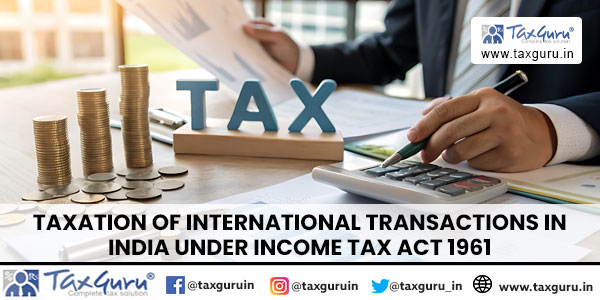International transactions are now common practice in a business environment where all countries are interconnected with one another. Commercial activities cross borders and permeate every area—from merchandising goods to foreign partnerships. However, when companies go global, they encounter a maze of tax laws. Here, a comprehension of Indian tax laws pertaining to international transactions becomes relevant for compliance and planning. This article attempts to address these complications and give a view of the Indian tax landscape.
India – Understanding the International Tax Paradigm
International transactions refer to various activities, including:
- Importing or exporting goods.
- Foreign collaborations for projects.
- Investments made in foreign entities.
According to Section 92B of the Income Tax Act, 1961, such transactions take place between two or more associated enterprises, crossing Indian boundaries.

Multifarious Key Taxation Laws and Rules:
The Indian taxation system is governed mainly under the Income Tax Act, 1961, with relevant sections being:
- Section 4: General Taxability.
- Section 90: Application of DTAAs.
- Section 91: Relief for income not taxable in India.
DTAAs are designed to provide tax relief to avoid double taxation of income. Several such treaties between India and other countries exist.
Tax Residency Status
Tax residency is the determining factor which decides the status of an entity or a person under Indian law.
- An individual qualifies to be a resident if they satisfy either one of the following conditions:
- He/she was present in India for 182 days or more in the current year.
- Present in India for 60 days or more in the current year and for 365 days or more during the last four years.
- An entity is treatable as resident if incorporated in India.
Foreign Source Income Taxation
Income from Business or Profession:
- International business income is generally taxable in India. A business will be taxed based on where the management resides, and the Permanent Establishment (PE) provisions could render foreign companies’ activities in India taxable depending on the provisions of the PE agreement.
For example, a foreign company that would like to set up a taxation presence in India, owing to a fixed place of business, could be taxed on income accruing in India. Capital gains from the sale of foreign properties are also taxed, with different tax rates applicable on different assets.
In nations like India, long-term capital gain taxation of foreign securities may also be lower than that of short-term ones. Statistics indicate that one of the key contributors to capital gains tax is the total tax revenue. Generally speaking, income from dividends, interest, and royalties received from foreign sources is taxable. However, DTAAs may reduce withholding tax rates, thus providing some relief. The foregoing information may help in better planning by businesses.
Withholding Tax and Tax Deduction at Source (TDS) Rates and Provisions
Rates and provisions that are applicable under TDS are deducted at source for international payments.
Some of the key sections of the Income Tax Act dealing with TDS on international payments are:
- Section 195: Tax deduction at source on foreign payments.
The rates also vary with the nature of the income. For instance, interest might have a different TDS rate than royalties. These compliances need to be observed with proper documentation and timely payment or else the companies may face a lot of extra taxation. The time period for documenting all transactions, invoices, and receipts is essential to compliance.
TDS Recovery
There are options for the recovery of excess withholding taxes. The recovery requires filing the forms under the respective DTAAs and the Income Tax Act. Documentary support should be available to the businesses to assist them in the process of claiming the recovery.
Transfer Pricing and Arm’s Length Principle
Understanding the Arm’s Length Principle (ALP):
- The Arm’s Length Principle stands at the heart of pricing in international transactions.
- Transactions between related parties should be priced as if they were carried out between unrelated parties to ensure fair taxation in line with the principle.
Methods for Determining Arm’s Length Prices
The methods that determine the arm’s length prices are:
- Comparable Uncontrolled Price Method.
- Cost Plus Method.
- Profit Split Method.
These methods, as recognized by OECD guidelines, are to facilitate the establishment of fair prices and thus avert tax disputes.
Documentation Requirements and Penalties
Companies maintaining transfer pricing practices should maintain records to avoid disputes.
APA and Dispute Resolution
Role of the APA in Transfer Pricing:
- APAs allow companies to reach agreements with tax authorities concerning transfer pricing arrangements for future transactions. This removes uncertainty and potential disputes over pricing.
- Current figures suggest an upward trend in the conclusion of APAs, providing businesses with greater certainty regarding their tax liabilities.
Dispute Resolution Mechanisms
- Taxpayers can carry their appeals against international transactions before appellate authorities.
- Arbitration mechanisms remain a dispute resolution avenue where disputes can be resolved.
Seeking Expert Advice
Complex international taxation issues require expert advice.
- Tax consultants help navigate the regulatory maze.
- “Understanding the intricate details of tax laws is essential for businesses engaged in international activities,” says a tax consultant.
Conclusion
Businesses must understand concepts such as tax residency, withholding taxes, and transfer pricing for compliance. Proactive tax planning can mitigate difficulties and maximize rewards. For companies involved in international transactions:
- Stay apprised of tax regulations and maintain documentation of all transactions.
- Avoid pitfalls by consulting tax professionals.
In a nutshell, with proper planning and informed decisions, businesses can thrive in the international arena while complying with Indian tax laws.




